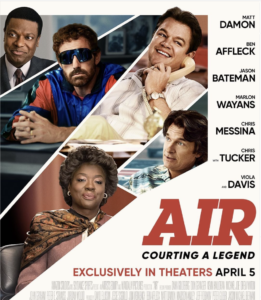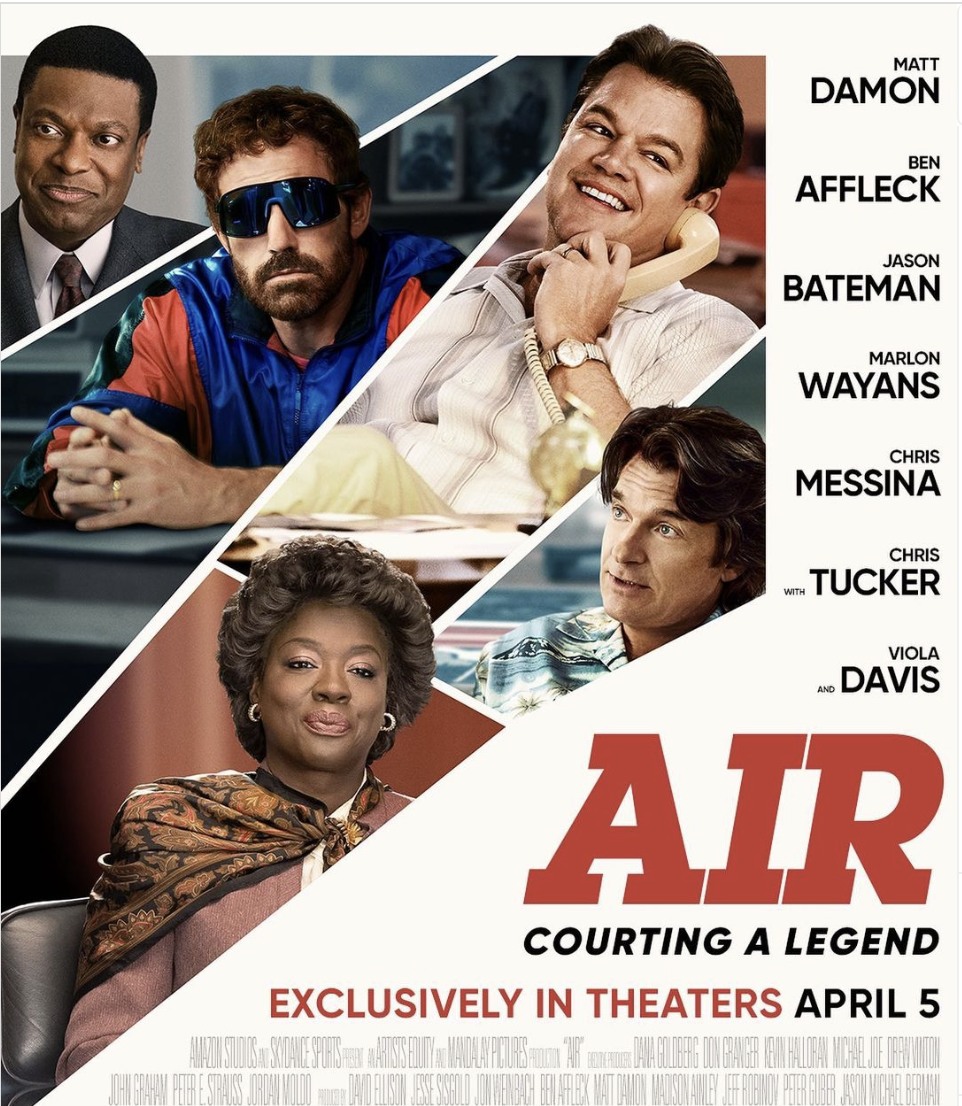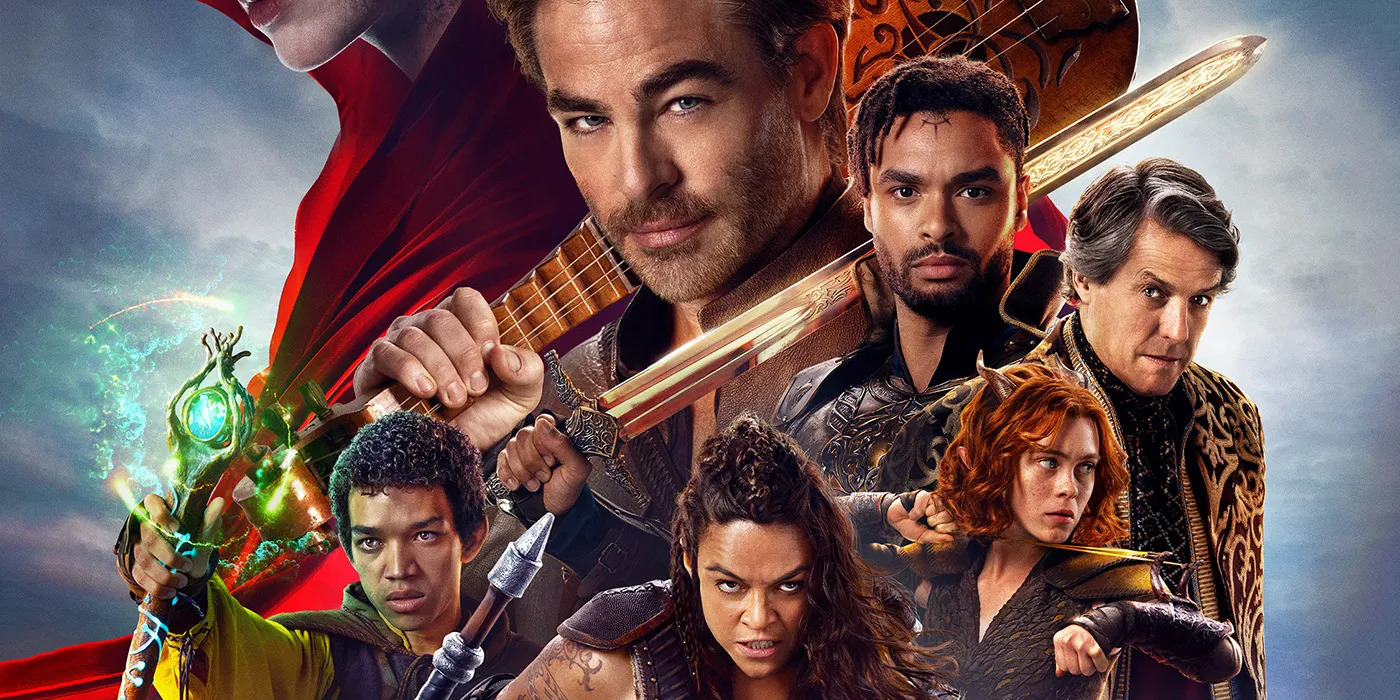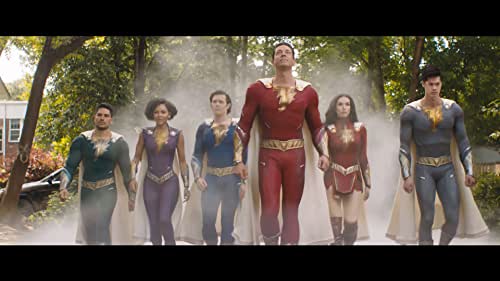Air
Posted on April 5, 2023 at 5:45 pm
B +| Lowest Recommended Age: | High School |
| MPAA Rating: | Rated R for language throughout |
| Profanity: | Very strong language |
| Alcohol/ Drugs: | Some alcohol |
| Violence/ Scariness: | None |
| Diversity Issues: | A theme of the movie |
| Date Released to Theaters: | April 7, 2023 |

Matt Damon plays Sonny, with director Ben Affleck as Nike founder Phil Knight. As the movie begins, In 1984, Nike was known as a running shoe company. Converse and Adidas had most of the market for basketball shoes. Nike, with only 17 percent, was considering giving up entirely. Vacarro, whose life could easily fill a few more movies, wants to change the division’s approach, a poor (in both senses of the word) imitation of the vastly more successful competition. They would pay the top athletes a set fee to appear on posters and ads, representing the brand. Sonny and his colleagues discussed the lower-tier athletes they might be able to afford but no one thought that pursuing the same failed strategy would produce a better result. They just did not know what else to try, and the old system might not work, but it was safe.
Nike was an upstart company, and, as Sonny reminded Phil Knight, before they were a public company, with all of the bureaucracy and high profile disclosures that requires, they were the opposite of safe. The film cleverly uses the company’s real-life principles as commentary or chapter headings. “Our business is change” is number one.
Sonny decides that instead of hedging their bets by picking three basketball players and hoping one of them would excel, they should spend their entire budget on Michael Jordan a #3 draft pick rookie who has not yet set foot on a professional court. He has to persuade his colleagues (Chris Tucker and Jason Bateman, both excellent as always). He has to persuade Knight. He has to persuade Jordan’s ultra-alpha agent, David Falk (Chris Messina, nailing it like the real-life Jordan buzzer-beater). And when Falk refuses to give Sonny a meeting, Sonny has to persuade Jordan’s parents, more specifically, Jordan’s mother Deloris.
She is played by the magnificent Viola Davis because that was real-life Jordan’s one request for the film. And she is on fire. A scene near the end has a phone conversation between Deloris and Sonny that will be in the highlight reels for both stars forever.
Affleck is a fine actor and a better-than-fine director. As an actor since childhood, his skill at selecting the right actors and allowing them to do their best is to be expected. He also has an exceptional sense of narrative structure. The script from first-time screenwriter Alex Avery was chosen as Best Unproduced/Blacklist Screenplay of 2021. He gets sole credit, but Affleck and Damon, Oscar-winning screenwriters in their 20s for “Good Will Hunting,” worked with him on the final version. It is the way the story is shaped that allows each of the characters to make a contribution and keeps us somehow wondering how it will come together.
There is also a deeper meaning, a medium is the message connection. It is the first film from a new company formed by Damon and Affleck that hopes to do for the people who work on films what Sonny did for Michael Jordan, recognizing the contributions of below-the-line crew like cinematographers, designers, and sound technicians with a chance to share in the profits of the work they help to create. Let’s hope they all do as well as Jordan, who, according to the film’s ending updates, makes $400 million a year from the Nike products bearing his name.
Parents should know that this film has constant strong “locker-room” language
Family discussion: What made Nike different from its competitors? Which of the Nike principles do you think are most important? Would you buy something just because it had the name of a celebrity on it?
If you like this, try: “Sole Man,” the ESPN 30 for 30 documentary about Sonny Vacaarro and some of the interviews with Vacarro on YouTube, especially the ones concerning his reversal from creating marketing programs that exploited amateur athletes to leading the Supreme Court challenge that recognized their right to be paid for the use of their images and names









